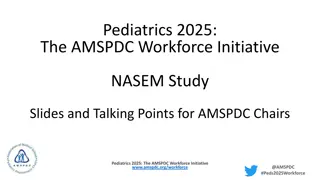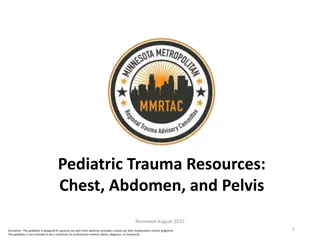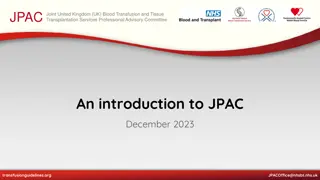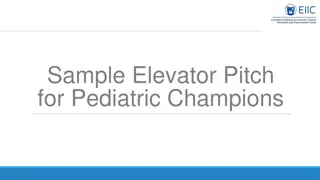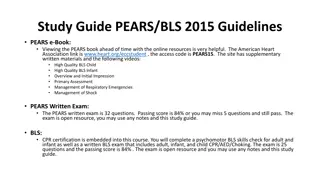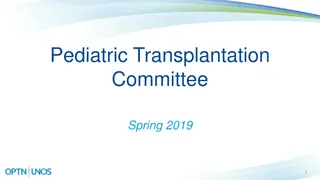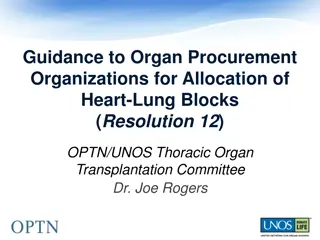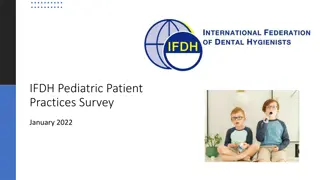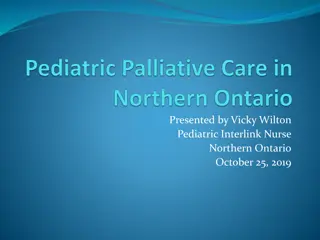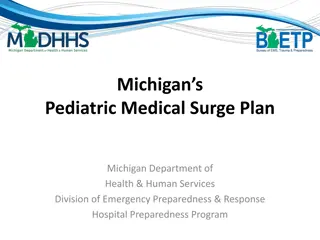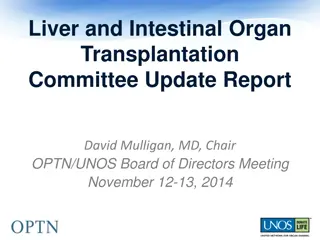Pediatric Transplantation Committee Projects
Board-approved projects in pediatric transplantation focusing on training, emergency membership exceptions, transfer practices to adult programs, and improving outcomes for pediatric liver candidates. Future projects aim to reduce waiting list mortality and enhance recipient follow-up after transfer.
Download Presentation

Please find below an Image/Link to download the presentation.
The content on the website is provided AS IS for your information and personal use only. It may not be sold, licensed, or shared on other websites without obtaining consent from the author.If you encounter any issues during the download, it is possible that the publisher has removed the file from their server.
You are allowed to download the files provided on this website for personal or commercial use, subject to the condition that they are used lawfully. All files are the property of their respective owners.
The content on the website is provided AS IS for your information and personal use only. It may not be sold, licensed, or shared on other websites without obtaining consent from the author.
E N D
Presentation Transcript
THEORY AND PRACTICE OF THEORY AND PRACTICE OF INFORMATION LITERACY INFORMATION LITERACY AND CULTURAL HERITAGE AND CULTURAL HERITAGE IN LIBRARIES, ARCHIVES IN LIBRARIES, ARCHIVES AND MUSEUMS: AND MUSEUMS: DEVELOPING A MODEL DEVELOPING A MODEL FOR LIFELONG LEARNING FOR LIFELONG LEARNING ACURIL 2014 ACURIL 2014 9 June 2014, Nassau, Bahamas 9 June 2014, Nassau, Bahamas K I M B A K E R K I M B A K E R
FROM CULTURAL HERITAGE TO INFORMATION LITERACY AND LIFELONG LEARNING Information literacy theory and practice well established, and applied in libraries Information literacy theory and practice well established, and applied in libraries Different approaches and levels depending on whether academic; public; school Different approaches and levels depending on whether academic; public; school or special library or special library Information literacy training delivered on Information literacy training delivered on- -site and in person, but increasingly online online Information literacy is intellectually based, designed to impart the ability to form Information literacy is intellectually based, designed to impart the ability to form search strategies, discover, evaluate, consolidate and use information, ethically search strategies, discover, evaluate, consolidate and use information, ethically Cultural heritage is personal, emotional, experiential and thus involves the senses Cultural heritage is personal, emotional, experiential and thus involves the senses to combine information literacy with cultural heritage, we first need to to combine information literacy with cultural heritage, we first need to understand more about the field of cultural heritage understand more about the field of cultural heritage site and in person, but increasingly
CULTURAL HERITAGE CULTURAL HERITAGE WHAT IS IT? WHAT IS IT?
CULTURAL HERITAGE CULTURAL HERITAGE - - DEFINITIONS An extensive Literature review found no clear definitions An extensive Literature review found no clear definitions of Cultural Heritage in the Library context, but several of Cultural Heritage in the Library context, but several partial definitions in other contexts; partial definitions in other contexts; DEFINITIONS In order to map a shared territory to facilitate further In order to map a shared territory to facilitate further exploration of Cultural Heritage in the Museums, exploration of Cultural Heritage in the Museums, (including Galleries), Archives and Library context that (including Galleries), Archives and Library context that was suitably encompassing, a frame of reference was was suitably encompassing, a frame of reference was constructed in place of attempting a definition. constructed in place of attempting a definition.
CULTURAL HERITAGE: FRAME OF REFERENCE CULTURAL HERITAGE: FRAME OF REFERENCE FOR MUSEUMS, ARCHIVES AND LIBRARIES FOR MUSEUMS, ARCHIVES AND LIBRARIES Libraries Libraries contain collections of documents, contain collections of documents, and located within and located within these documents are these documents are records records of the cultural of the cultural and intellectual and intellectual life and and history of the people of the world. history of the people of the world. The recorded recorded culture can culture can be considered be considered to contain part of contain part of the material the material (tangible), well as the intangible cultural heritage well as the intangible cultural heritage of the people of the world, and this is of the people of the world, and this is constantly constantly changing changing up to up to present life The to as (tangible), as present time . time .
CULTURAL HERITAGE: FRAME OF REFERENCE FOR CULTURAL HERITAGE: FRAME OF REFERENCE FOR MUSEUMS, ARCHIVES AND MUSEUMS, ARCHIVES AND LIBRARIES (CONT.) LIBRARIES (CONT.) Culture Culture embraces a broad set of embraces a broad set of reflections reflections of human endeavour of human endeavour including traditions, customs, beliefs, including traditions, customs, beliefs, values, religions values, religions, arts, social behavior, , arts, social behavior, knowledge systems, rituals knowledge systems, rituals and laws In many contexts, political systems In many contexts, political systems shaped and shaped and changed cultural changed cultural practices, and the factors that practices, and the factors that influence and shape influence and shape the culture people form an intrinsic part of that people form an intrinsic part of that heritage . heritage . and laws. . the culture of of
CULTURAL HERITAGE: FRAME OF REFERENCE FOR CULTURAL HERITAGE: FRAME OF REFERENCE FOR MUSEUMS, ARCHIVES AND LIBRARIES ( MUSEUMS, ARCHIVES AND LIBRARIES (CONT.) CONT.) In deference to the school of thought In deference to the school of thought that is postmodernism, the formation and that is postmodernism, the formation and creation of these documents in their social creation of these documents in their social and political context thus form part of the and political context thus form part of the interpretive narrative within the environment interpretive narrative within the environment of cultural heritage. of cultural heritage. (Baker, K. 2013. (Baker, K. 2013. Information Literacy and Information Literacy and Cultural Heritage: developing a model for Cultural Heritage: developing a model for lifelong learning lifelong learning. Oxford: Chandos: p8) . Oxford: Chandos: p8)
POSTMODERNISM: WHAT IS IT? POSTMODERNISM: WHAT IS IT? There is extensive exploration of Postmodernism in both the Museums and There is extensive exploration of Postmodernism in both the Museums and Archival fields, but libraries have not yet really engaged with Postmodernism and Archival fields, but libraries have not yet really engaged with Postmodernism and how it relates to Cultural Heritage how it relates to Cultural Heritage MUSEUM SCIENCE: MUSEUM SCIENCE: Among many scholarly articles and books, Among many scholarly articles and books, Mason identified Jacques (Mason (Mason, 2006: 21) and Michel Foucault (ibid.: 23) as , 2006: 21) and Michel Foucault (ibid.: 23) as having a influence on museum theory and practice, influence on museum theory and practice, with deconstructions deconstructions challenging challenging traditional practices. traditional practices. This influence museums who have thoroughly re museums who have thoroughly re- -examined their examined their role in presenting and interpreting cultural presenting and interpreting cultural heritage Mason identified Jacques Derrida having a significant with postmodernist postmodernist This influence is evident in role in collecting, preserving collecting, preserving, , heritage. Derrida significant is evident in
POSTMODERNISM: WHAT IS IT POSTMODERNISM: WHAT IS IT? ( ? (CONT CONT) ) MUSEUM SCIENCE (continued): MUSEUM SCIENCE (continued): Kraeutler : issues Kraeutler : issues of heritage learning of heritage learning in museums seen of a of a particular time particular time, embedded in the , embedded in the contextualities political political climates. climates. Heritage Heritage can be expressed in can be expressed in both materiality of objects) and also in of objects) and also in mindsets, including mindsets, including relations, languages and mentalities. mentalities. in museums seen as representative contextualities of social and both materiality (collections relations, languages and as representative of social and (collections H Heritage eritage is not powerful role powerful role in connecting between between the tangible and intangible aspects of the tangible and intangible aspects of heritage. (Kraeutler, 2008: 19) 19) is not neutral neutral and in connecting collections and communities, and collections and communities, and interfacing and thus museums are placed to play a thus museums are placed to play a interfacing heritage. (Kraeutler, 2008:
POSTMODERNISM: WHAT IS IT? ( POSTMODERNISM: WHAT IS IT? (CONT.) CONT.) ARCHIVAL SCIENCE: ARCHIVAL SCIENCE: Cook: Postmodernism is Cook: Postmodernism is encouraging, through deconstruction deconstruction, the fragmenting , the fragmenting of the encouraging encouraging ambiguity and ambiguity and multiple ways of the the place where place where social memory social memory is constructed occurs in support occurs in support of the metanarratives of the of the metanarratives of the powerful. now viewed now viewed as a mere trace of as a mere trace of a missing universe, and is and reflects and reflects the intentions of the the intentions of the creator The archive is an The archive is an ever ever- -changing changing cultural construct record of empirical fact record of empirical fact (Cook, 2001: 25 encouraging, through the critical of the former modernist paradigm while former modernist paradigm while multiple ways of seeing is constructed, and powerful. T The a missing universe, and is a a mirror that creator and and the the audience audience cultural construct rather than a (Cook, 2001: 25 - -27) 27) the critical analytical tool of analytical tool of seeing. The , and this this construction construction he archival record itself is archival record itself is mirror that both distorts . The archive archive is is both distorts rather than a
WHY WAS POSTMODERNISM SELECTED? WHY WAS POSTMODERNISM SELECTED? Postmodernism allows the for idea that cultural heritage and the recording, Postmodernism allows the for idea that cultural heritage and the recording, interpretation, classification and presentation of it is CONSTRUCTED and interpretation, classification and presentation of it is CONSTRUCTED and SUBJECTIVE; SUBJECTIVE; It allows for MULTIPLE VIEWPOINTS and emphasizes CONTEXT; It allows for MULTIPLE VIEWPOINTS and emphasizes CONTEXT; It allows for the recognition of MEMORY as an intrinsic component of cultural It allows for the recognition of MEMORY as an intrinsic component of cultural heritage and takes into account the fact that MEMORY is subjective and subject to heritage and takes into account the fact that MEMORY is subjective and subject to distortions and interference; distortions and interference; It allows for CONTESTED HISTORY to enter the interpretative narrative, thus It allows for CONTESTED HISTORY to enter the interpretative narrative, thus opening the way for critical thinking and debate. It thus moves away from opening the way for critical thinking and debate. It thus moves away from EXCLUSION to INCLUSION. EXCLUSION to INCLUSION.
WHY IS THE PRESENTATION OF MULTIPLE VIEWS WHY IS THE PRESENTATION OF MULTIPLE VIEWS IMPORTANT IN CULTURAL HERITAGE NARRATIVES? IMPORTANT IN CULTURAL HERITAGE NARRATIVES?
WHY IS WHY IS M MEMORY SUBJECTIVE? EMORY SUBJECTIVE? Appaiah: Appaiah: Archives thus thus the the politics politics of memory identity identity - - which which means that memories become means that memories become political, and always, there are groups of people selected for inclusion, and others for exclusion. groups of people selected for inclusion, and others for exclusion. (Appaiah, 2011 : 99 99 100). 100). Archives are a are a construct of construct of history, often directed by state officials, and history, often directed by state officials, and of memory influences every state and every influences every state and every creation of political, and always, there are creation of (Appaiah, 2011 : Jimerson: Jimerson: Four Collective Collective memory authenticity authenticity and validity. and validity. Personal memory the fact the fact that memory that memory can change over biases. (Jimerson, 2003: 89 biases. (Jimerson, 2003: 89 90) Four categories of categories of memory memory as social as social memory is seldom memory is seldom examined Personal memory as eyewitness testimony is subject to as eyewitness testimony is subject to can change over time or be influenced by distorting personal time or be influenced by distorting personal 90) memory - - personal, collective personal, collective, historical and archival examined for , historical and archival . . for reliability, reliability,
QUESTIONS TO BE ASKED WITH REGARD TO QUESTIONS TO BE ASKED WITH REGARD TO PRESENTING CULTURAL HERITAGE PRESENTING CULTURAL HERITAGE Museums and archives have been asking these questions for more than a decade: Museums and archives have been asking these questions for more than a decade: Who defines cultural heritage? Who defines cultural heritage? Who created it, and what were the contextual influences on them and their creation Who created it, and what were the contextual influences on them and their creation of it? of it? In selecting what to collect, preserve and present: Who decided? What influenced In selecting what to collect, preserve and present: Who decided? What influenced their decision on what to include, and what to exclude, and why? their decision on what to include, and what to exclude, and why? Who described it, and what are the personal biases they had? Are all these Who described it, and what are the personal biases they had? Are all these contextual factors included with the narrative? contextual factors included with the narrative? Libraries have very seldom asked these questions when embarking on digitization Libraries have very seldom asked these questions when embarking on digitization projects of cultural heritage projects of cultural heritage. .
CULTURAL HERITAGE IN DIGITAL INFORMATION CULTURAL HERITAGE IN DIGITAL INFORMATION CONTEXTS CONTEXTS Marshall: Marshall: The reduction of data into binary code (digitization) meant that it can be The reduction of data into binary code (digitization) meant that it can be altered and manipulated altered and manipulated thus integrity of data is not always a given thus integrity of data is not always a given (Marshall: 2004: 17) (Marshall: 2004: 17) Digital images convey a a representation the increase in increase in power to manipulate images, change them and power to manipulate images, change them and widely. As more people become media literate and more people become media literate and representation, with Lacey: Lacey: Digital images convey digitization digitization comes comes the transmit them transmit them instantly and instantly and widely. As aware aware that that the media the media deals with representation and not reality deals with representation and not reality, , the the more likely more likely they are to they are to question reporting of the news and question reporting of the news and not just accept at face at face value value (Lacey (Lacey, 1998: , 1998: 222 222 - - 224). 224). , with the development of the development of not just accept reports reports
CULTURAL HERITAGE IN THE DIGITAL WORLD: CULTURAL HERITAGE IN THE DIGITAL WORLD: CHALLENGES TO TRADITIONAL GATEKEEPERS CHALLENGES TO TRADITIONAL GATEKEEPERS Tredinnick Tredinnick: Transglobal : Transglobal cultural are now possible are now possible in the shaped shaped from the top down but, rather, from the bottom from the top down but, rather, from the bottom up. From that the that the traditional institutions traditional institutions of museums, archives and libraries role of museums, archives and libraries role as exclusive purveyors of cultural heritage purveyors of cultural heritage are are being being significantly challenged. (Tredinnick: 2006: significantly challenged. (Tredinnick: 2006: 65 65). ). cultural formations not formations not shaped by corporate organizations shaped by corporate organizations in the digital world, and thus interactions are no longer digital world, and thus interactions are no longer being being up. From this, it can be noted this, it can be noted as exclusive Cameron Cameron: The UNESCO : The UNESCO Memory of the World as to what heritage means in as to what heritage means in the context heritage heritage is a is a selective pool of materials selective pool of materials deemed worthy and this considered a and this considered a Eurocentric idea for producing identity Eurocentric idea for producing identity (Cameron: 2008: Memory of the World Programme has the context of the current heritage debates. of the current heritage debates. Digital deemed worthy for preservation for posterity, Programme has little critical reflexivity little critical reflexivity Digital for preservation for posterity, (Cameron: 2008: 172). 172).
CULTURAL HERITAGE IN THE DIGITAL WORLD: CULTURAL HERITAGE IN THE DIGITAL WORLD: CHALLENGES TO CHALLENGES TO TRADITIONAL GATEKEEPERS TRADITIONAL GATEKEEPERS (CONT.) (CONT.) Cameron Cameron: : Items Items selected to be preserved rely selected to be preserved rely on selection valuable, and valuable, and thus other thus other items are silenced (ibid.: 177). items are silenced (ibid.: 177). UNESCO authority over the processes authority over the processes of making of making meaning (ibid.: 179 G Groups who are excluded from the authorities (UNESCO and other roups who are excluded from the authorities (UNESCO and other official using their own criteria to using their own criteria to craft their craft their own identities and cultural materials in digital own identities and cultural materials in digital format, and format, and this is being facilitated by social media. this is being facilitated by social media. The Internet enables definition of position definition of position and allows bypass of and allows bypass of authorities such as are thus are thus ignoring ignoring the cultural domination of traditional the cultural domination of traditional institutions. Individuals social media social media to reconstitute their own cultural codes and to reconstitute their own cultural codes and disrupt, challenge subvert established hierarchies of subvert established hierarchies of digital heritage digital heritage selection on selection criteria of what is deemed to be criteria of what is deemed to be UNESCO exercises cultural meaning (ibid.: 179 80 exercises cultural 80). ). official bodies), bodies), are are The Internet enables independent authorities such as UNESCO. UNESCO. Communities institutions. Individuals can use disrupt, challenge and selection (Cameron: 172 (Cameron: 172- -180) independent Communities can use and 180)
CULTURAL HERITAGE IN THE DIGITAL WORLD: CULTURAL HERITAGE IN THE DIGITAL WORLD: CHALLENGES TO CHALLENGES TO ACCESSIBILITY AND USABILITY ACCESSIBILITY AND USABILITY A few of the challenges are highlighted here: A few of the challenges are highlighted here: Two thirds of the world do not as yet have access to the Internet; Two thirds of the world do not as yet have access to the Internet; Of the one third that has access, many cannot afford the costly bandwidth Of the one third that has access, many cannot afford the costly bandwidth packages that allow for viewing of high bandwidth digital collections packages that allow for viewing of high bandwidth digital collections specifically videos) specifically videos) Placing content of cultural heritage on the Internet does not imply discoverability Placing content of cultural heritage on the Internet does not imply discoverability - - even if discovered, this does not imply integration of the information, critical even if discovered, this does not imply integration of the information, critical analysis, and use of it to create new knowledge. analysis, and use of it to create new knowledge. D Data on number of hits is quantitative and does not provide qualitative measure of how and if the material quantitative and does not provide qualitative measure of how and if the material is used is used ata on number of hits is
ENTER THE LIBRARIES: INFORMATION LITERACY ENTER THE LIBRARIES: INFORMATION LITERACY Libraries have the opportunity to Libraries have the opportunity to make themselves relevant to the make themselves relevant to the cultural heritage sector, as they have cultural heritage sector, as they have a a unique asset to offer: unique asset to offer: the well developed pedagogy of the well developed pedagogy of Information Literacy (Or, Media and Information Literacy (Or, Media and Information Literacy as it is now Information Literacy as it is now termed). termed).
LIBRARIES AND THE ROLE OF INFORMATION LITERACY IN LIBRARIES AND THE ROLE OF INFORMATION LITERACY IN TEACHING CULTURAL HERITAGE AWARENESS TEACHING CULTURAL HERITAGE AWARENESS Libraries have a well developed pedagogy of Information Literacy which can easily be Libraries have a well developed pedagogy of Information Literacy which can easily be integrated with Cultural Heritage training in Museums, Archives and Libraries; integrated with Cultural Heritage training in Museums, Archives and Libraries; R Review of the main models of Information Literacy: eview of the main models of Information Literacy: The Big6 Research Process Model ( Research Process Model (REACTS), Pappas REACTS), Pappas and Tepe s Pathways to Knowledge Model; the the Digital Information Digital Information Fluency Model (21CIF); Kuhlthau s Fluency Model (21CIF); Kuhlthau s Information Search Model; the SCONUL Seven Pillars of Model; the SCONUL Seven Pillars of Information Skills Information Skills Model; ACRL Information Literacy Literacy Competency Standards Competency Standards for Higher Education; the ANZIL (Australian for Higher Education; the ANZIL (Australian and New Zealand Information Literacy) Framework; and Zealand Information Literacy) Framework; and the UNESCO Indicators Indicators revealed none were found to be completely suitable for the purpose of revealed none were found to be completely suitable for the purpose of teaching cultural heritage awareness. teaching cultural heritage awareness. The Big6 ; the and Tepe s Pathways to Knowledge Model; Information Search Process Model; ACRL Information ; the Stripling and Pitts Stripling and Pitts Process and New the UNESCO Information Literacy Information Literacy
MODELS MODELS OF INFORMATION LITERACY STAGES AND PROCESSES: OF INFORMATION LITERACY STAGES AND PROCESSES: The The Big6 Big6 (Developed in 1990 (Developed in 1990 by Eisenberg and Berkowitz, American schools). American schools). The The big six are big six are: : task definition (defining the problem and task definition (defining the problem and information needed the formulation of information the formulation of information- -seeking strategies ( available, and selecting available, and selecting the most applicable sources the most applicable sources to be accessed); the location and access of the information the location and access of the information required; using using the information (this part entails reading the information (this part entails reading the information what is relevant); what is relevant); synthesizing the information (organizing and synthesizing the information (organizing and presenting it evaluating the information to judge whether it met evaluating the information to judge whether it met the requirements desired outcome. desired outcome. (Eisenberg and Berkowitz, 1990) (Eisenberg and Berkowitz, 1990) by Eisenberg and Berkowitz, and was used in and was used in information needed); ); finding out what is to be accessed); required; the information, and extracting seeking strategies (finding out what is , and extracting presenting it); and the requirements of the ); and of the
MODELS MODELS OF INFORMATION LITERACY STAGES AND PROCESSES: OF INFORMATION LITERACY STAGES AND PROCESSES: The Stripling and Pitts Research The Stripling and Pitts Research Process Model This model was developed specifically to facilitate This model was developed specifically to facilitate the research process in an academic environment, and has environment, and has ten steps: ten steps: 1 1 - - choice choice of a of a topic; 2 topic; 2 - - gain a gain a broad overview of the topic broad overview of the topic; ; 3 3 - - narrow narrow down the down the topic; 4 topic; 4 - - formulate a formulate a thesis; thesis; 5 5 - - identify research questions; 6 identify research questions; 6 - - plan the plan the research; 7 7 - - search search for information for information and evaluate and evaluate the applicability of the applicability of the resources; 8 8 - - evaluate evaluate the sources the sources found and construct a bibliography; found and construct a bibliography; 9 9 - - compile compile all the information all the information gathered into gathered into a framework, sources, assess arguments; sources, assess arguments; 10 10 - - final writing and presentation of final writing and presentation of the assignment/report/paper the assignment/report/paper. . Suitable Suitable for an for an academic approach academic approach to research, to research, but too assessing different cultural heritage sources. assessing different cultural heritage sources. Process Model (REACTS (REACTS) (1998) the research process in an academic ) (1998) research; the resources; a framework, review review the validity of the the validity of the but too advanced for advanced for the the context of context of
MODELS MODELS OF INFORMATION LITERACY STAGES AND PROCESSES: OF INFORMATION LITERACY STAGES AND PROCESSES: Pappas and Tepe s Pathways Pappas and Tepe s Pathways to Knowledge The The model provided detailed descriptions of: the model provided detailed descriptions of: the principles of content standards; the tenets of content standards; the tenets of democracy; technology knowledge and behavior required knowledge and behavior required by As As a model of process, a model of process, aspects aspects that would be applicable to information literacy information literacy and cultural and cultural heritage awareness in the of of lifelong learning are technological competencies; and emphasis lifelong learning are technological competencies; and emphasis on teacher knowledge and on teacher knowledge and behavior, but this was devised behavior, but this was devised specifically for learning in specifically for learning in schools schools The promotion of the tenets and The promotion of the tenets and values of suitable suitable for the for the development of the development of the generic model of information literacy and literacy and cultural heritage cultural heritage, since promoting one set of values as , since promoting one set of values as preferable preferable to those to those held by other cultures would defeat the held by other cultures would defeat the objectives objectives of the model (generic) of the model (generic) to Knowledge Model (1995) Model (1995) principles of learning; ; and the learning; democracy; technology; and the by teachers teachers that would be applicable to heritage awareness in the context context values of democracy democracy was not generic model of information was not
MODELS MODELS OF INFORMATION LITERACY STAGES AND PROCESSES: OF INFORMATION LITERACY STAGES AND PROCESSES: The Digital Information Fluency The Digital Information Fluency Model Specifically shaped around digital Described digital information digital information fluency as the ability to locate, and and use digital use digital information in an effective, efficient and information in an effective, efficient and ethical manner manner. . Digital information fluency included the differences differences between digital and between digital and print information The model is a circular circular one, one, begins the process with a series of questions: What information am : What information am I looking information? How will information? How will I get I get there? How good is the information? How there? How good is the information? How will I will I ethically use ethically use the information? the information? Sanderson questioned the models use in the cultures and approaches to cultures and approaches to learning, noted learning, noted that some learning behaviours behaviours may be different may be different to Western thinking thinking (Sanderson, 2011: 15). Model (21CIF digital information. information. fluency as the ability to locate, analyse (21CIF) ) analyse ethical the ability to distinguish the ability to distinguish the print information. . I looking for? Where will I find the for? Where will I find the in the context of different context of different that some learning to Western approaches to critical approaches to critical
MODELS MODELS OF INFORMATION LITERACY STAGES AND PROCESSES: OF INFORMATION LITERACY STAGES AND PROCESSES: Kuhlthau s Information Search Process Kuhlthau s Information Search Process Model Model Summary Summary: T while while the users process of construction is shaped by the users process of construction is shaped by feelings of confusion and and uncertainty at various uncertainty at various stages ( stages (Kuhlthau, 2004 Kuhlthau, 2004 : : 8). Six Six intervention strategies for intervention strategies for the librarian the librarian to seeking seeking process: process: facilitating collaboration (working with others); facilitating collaboration (working with others); continuing (going forward from more than one point); continuing (going forward from more than one point); choosing (what the user considered to be relevant); choosing (what the user considered to be relevant); charting (visualizing ideas, mapping strategies, charting (visualizing ideas, mapping strategies, posing questions identifying issues); identifying issues); conversing ( conversing (dialoguing dialoguing with the librarian and others with the librarian and others to seek identify further questions); and identify further questions); and composing (writing down what has been formulated composing (writing down what has been formulated and identified missing missing). (Ibid: 135) ). (Ibid: 135) : The bibliographic he bibliographic paradigm is framed by certainty and paradigm is framed by certainty and order, order, feelings of confusion 8). to follow: follow: posing questions and and to seek clarity and clarity and and identified as as
MODELS MODELS OF INFORMATION LITERACY OF INFORMATION LITERACY STANDARDS, COMPETENCIES PERFORMANCE INDICATORS : PERFORMANCE INDICATORS : STANDARDS, COMPETENCIES AND AND Evaluated were: SCONUL Evaluated were: SCONUL Seven Pillars of Information Skills Seven Pillars of Information Skills Model; ACRL Information Literacy Competency Standards for Model; ACRL Information Literacy Competency Standards for Higher Education; the ANZIL (Australian and New Zealand Higher Education; the ANZIL (Australian and New Zealand Information Literacy) Framework; Information Literacy) Framework; 21C IF and Information Literacy Information Literacy Indicators Indicators 21C IF and the UNESCO the UNESCO While any group wishing to adapt the generic model to their own While any group wishing to adapt the generic model to their own context is free to incorporate any of these models, it was found context is free to incorporate any of these models, it was found that for free choice, lifelong learning, the system of PMM that for free choice, lifelong learning, the system of PMM (Personal Meaning mapping) developed for museums is most (Personal Meaning mapping) developed for museums is most suitable for assessing the general public suitable for assessing the general public
A NEW MODEL: INFORMATION LITERACY AND A NEW MODEL: INFORMATION LITERACY AND CULTURAL HERITAGE FOR LIFELONG LEARNING CULTURAL HERITAGE FOR LIFELONG LEARNING The new model developed for Museums, The new model developed for Museums, Archives and Libraries to converge to teach Archives and Libraries to converge to teach Information Literacy and Cultural Heritage Information Literacy and Cultural Heritage awareness for lifelong learning for the general awareness for lifelong learning for the general public, is generic, and is a dialectic synthesis public, is generic, and is a dialectic synthesis of the Didactic, Positivist tradition of Libraries, of the Didactic, Positivist tradition of Libraries, and the Constructivist, Postmodernist and the Constructivist, Postmodernist approach of Museums and Archives for both approach of Museums and Archives for both Digital and Non Digital and Non- -Digital contexts. Digital contexts.
SUMMARY OUTLINE OF THE MODEL SUMMARY OUTLINE OF THE MODEL Catalysts: Catalysts: The The learning Components Components : : Carrier Carrier, , Content Core processes and Core processes and tasks: Discover; Learn; Evaluate; Create; Share; Feedback; Modify Discover; Learn; Evaluate; Create; Share; Feedback; Modify Generic learning Generic learning outcomes: outcomes: Skills; Attitudes and values; Knowledge and Understanding; Behaviour and Skills; Attitudes and values; Knowledge and Understanding; Behaviour and activity; Enjoyment, inspiration, creativity. activity; Enjoyment, inspiration, creativity. Measurement: Measurement: Personal Meaning mapping (PMM) Personal Meaning mapping (PMM) Contextual fluidity: Contextual fluidity: (Allows for the model to be adapted to different cultural contexts, political (Allows for the model to be adapted to different cultural contexts, political environments and rapidly changing technologies and developments) environments and rapidly changing technologies and developments) learning environment environment museums (including museums (including galleries galleries); ); archives; archives; libraries libraries Content and and Context Context tasks:
THE CORE CONTRIBUTION FROM LIBRARIES AND THE CORE CONTRIBUTION FROM LIBRARIES AND INFORMATION LITERACY: INFORMATION LITERACY: How to discover, How to discover, assess, critically assess, critically evaluate evaluate arguments, learn arguments, learn logical thinking, logical thinking, and use and use information to information to create new create new knowledge. knowledge.
CORE CONTRIBUTION FROM MUSEUMS AND ARCHIVES: CORE CONTRIBUTION FROM MUSEUMS AND ARCHIVES: CULTURAL HERITAGE AWARENESS CULTURAL HERITAGE AWARENESS Understand cultural Understand cultural heritage in terms of heritage in terms of context, memory and context, memory and contested history, learn contested history, learn about different worldviews about different worldviews without being threatened without being threatened by them (worldview by them (worldview literacy; tolerance and literacy; tolerance and respect for different respect for different cultures locally and cultures locally and globally) globally)
REFERENCES REFERENCES 21CIF (21st Century Information Fluency Project) ( 21CIF (21st Century Information Fluency Project) (2011) http http://21cif.com/resources/difcore/index.html ://21cif.com/resources/difcore/index.html (accessed 2011) Digital Digital Information Fluency Model Information Fluency Model. Available (accessed 7 August 7 August 2012). 2012). . Available from: from: ACRL (2000) ACRL (2000) Information Literacy Competency Information Literacy Competency Standards for Research Libraries (ACRL) Research Libraries (ACRL). Available from: . Available from: http:// 2012). 2012). Standards for Higher Education Higher Education The Association of College and http://www.ala.org/acrl/standards/informationliteracycompetency www.ala.org/acrl/standards/informationliteracycompetency (accessed The Association of College and (accessed 7 August 7 August Appaiah Appaiah, K.A. (2011) Identity, politics, and the archive. , K.A. (2011) Identity, politics, and the archive. In X and Identity in South and Identity in South Africa Africa. Johannesburg . Johannesburg: Wits University Press (pp. In X. Mangcu (ed.), . Mangcu (ed.), Becoming Worthy Ancestors: Becoming Worthy Ancestors: Archive, Public : Wits University Press (pp. 99 99- -100). 100). Archive, Public Deliberation Deliberation Baker, K. (2013). Information Literacy and Cultural Heritage: developing a model for lifelong learning. Oxford: Chandos (pp. Baker, K. (2013). Information Literacy and Cultural Heritage: developing a model for lifelong learning. Oxford: Chandos (pp.8). 8). Cameron, F. (2008) The politics of heritage authorship: Cameron, F. (2008) The politics of heritage authorship: the case (eds.), (eds.), New Heritage: New Media New Heritage: New Media and Cultural . . Cook, T. (2001) Fashionable nonsense or Cook, T. (2001) Fashionable nonsense or professional rebirth the case of digital heritage collections. In Y.E. Kalay, T. of digital heritage collections. In Y.E. Kalay, T. Kvan and Heritage. London and New York: . London and New York: Routledge/ Taylor Routledge/ Taylor & Francis (pp. Kvan and J. Affleck 172 180) 180) J. Affleck and Cultural Heritage & Francis (pp. 172 professional rebirth: postmodernism and the practice of : postmodernism and the practice of archives. archives. Archivaria Archivaria 51: 51: 25 25- -27. 27. Eisenberg, M. and Berkowitz, R. (1990) Eisenberg, M. and Berkowitz, R. (1990) The Big6 The Big6. . Available from Available from: : http://www.big6.com/ http://www.big6.com/ (accessed 7 August 2012). (accessed 7 August 2012). Jimerson, R.C. (2003) Archives and memory. Jimerson, R.C. (2003) Archives and memory. OCLC Systems OCLC Systems & Services & Services 19(3): 19(3): 89 89 90. 90.
REFERENCES (CONTINUED) REFERENCES (CONTINUED) Kraeutler, H. (2008) Rich issues with reason Kraeutler, H. (2008) Rich issues with reason museums and heritage learning. In H. Kraeutler (ed.), museums and heritage learning. In H. Kraeutler (ed.), Heritage Learning Museums and Universal Heritage Museums and Universal Heritage. Proceedings of the ICOM/CECA 2007 Conference, . Proceedings of the ICOM/CECA 2007 Conference, Vienna, 20 Heritage Learning Matters: 4 August 2007: 19 Matters: Vienna, 20 4 August 2007: 19 Kuhlthau, C.C. (ed.) (2004) Kuhlthau, C.C. (ed.) (2004) Seeking Meaning: A Libraries Unlimited Libraries Unlimited. . Seeking Meaning: A Process Approach Process Approach to Library and Information Services to Library and Information Services, , 2 2nd nd edition edition. Westport, CT: . Westport, CT: Lacey Lacey, N. (1998) , N. (1998) Image and Representation: Key Concepts Image and Representation: Key Concepts in Media Studies in Media Studies. Hampshire, UK: Palgrave. (pp. 222 . Hampshire, UK: Palgrave. (pp. 222 224) 224) Marshall Marshall, P.D. (2004) , P.D. (2004) New Media Cultures New Media Cultures. London: Arnold. (pp. 17 . London: Arnold. (pp. 17) ) Mason Mason, R. (2006) Cultural theory and museum studies. In S. Macdonald (ed.), , R. (2006) Cultural theory and museum studies. In S. Macdonald (ed.), A Companion to Museum Studies Blackwell Publishing (pp. Blackwell Publishing (pp. 21 21- -23) 23) Pappas Pappas, M. and Tepe, A. (1995) , M. and Tepe, A. (1995) Pathways to Available Available from : from : http://www.intime.uni.edu/model/information/proc.html http://www.intime.uni.edu/model/information/proc.html ( accessed 7 A Companion to Museum Studies. Malden, MA: Pathways to Knowledge Knowledge. Illinois . Illinois: Follett Software Company. ( accessed 7 August 2012 August 2012). ). . Malden, MA: : Follett Software Company. Stripling and Pitts Research Process Model (1988). Stripling and Pitts Research Process Model (1988). Available from: http http:// ://slisweb.sjsu.edu/courses/250.loertscher/modelstrip.html slisweb.sjsu.edu/courses/250.loertscher/modelstrip.html (accessed 7 August 2012 Available from: (accessed 7 August 2012). ). Tredinnick Tredinnick, L. (2006) , L. (2006) Digital Information Contexts: Theoretical Approaches to Understanding Digital Digital Information Contexts: Theoretical Approaches to Understanding Digital Information Information. Oxford: Chandos Publishing. (pp. 65). . Oxford: Chandos Publishing. (pp. 65).
THANK YOU FOR YOUR ATTENTION THANK YOU FOR YOUR ATTENTION Kim Baker Kim Baker Blog: Blog: E E- -mail: mail: kbaker.research21c@gmail.com kbaker.research21c@gmail.com Twitter: Twitter: @iKbaker @iKbaker http http:// ://kimbakercapetown.wordpress.com kimbakercapetown.wordpress.com


